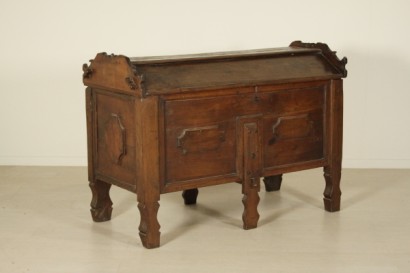Asilah, Arcila
Features
Style: Baroque (1630-1730)
Age: 17th Century / 1601 - 1700
Origin: Emilia Romagna, Italy
Main essence: Chestnut
Material: Solid Chestnut , Solid Elm
Description
Asilah, arcila, mobile container of wheat flour or chestnut wood and solid Elm. On the front and flanks moulded tiles typical of the region. The plan consists of three sliding boards assembled with wooden plugs he shaped sides. The legs end in feet to jar. Inside, the floor support is not coeval.
Product Condition:
Requires small restoration and resumption of polishing.
Dimensions (cm):
Height: 102
Width: 146
Depth: 67
Certificate issued by: Dott. Cuoccio Vittorio
Additional Information
Style: Baroque (1630-1730)
Read more
The term derives from the Spanish barrueco phoneme or Portuguese barroco and literally means "shapeless pearl".
Already around the middle of the eighteenth century in France it was synonymous with uneven, irregular, bizarre, while in Italy the term was of Medieval memory and indicated a figure of the syllogism, an abstraction of thought.
This historical period was identified with the derogatory term baroque, recognizing in it extravagance and contrast with the criteria of harmony and expressive rigor to which it was intended to return under the influence of Greco-Roman art and the Italian Renaissance.
Baroque, seventeenth-century and seventeenth-century were synonymous with bad taste.
As regards furniture, freedom of ideation, need for pomp and virtuosity gave rise to a synergy destined to produce unsurpassed masterpieces.
The materials used were worthy of competing with the most astonishing tales of Marco Polo: lapis lazuli, malachite, amber, ivory, tortoiseshell, gold, silver, steel, precious wood essences and more dressed the furnishings that in shape and imagination virtually gave life to the Arabian Nights of many of our powerful people.
Typical of the period were load-bearing or accessory parts resolved with twisted column motifs, clearly inspired by Bernini's canopy of St. Peter's, parts with rich sculptural carving in high relief and even in the round within a vortex of volutes, scrolls and spirals, curved and broken profiles, cymatiums agitated by gables of articulated shape, aprons adorned with ornaments, corbels, buttresses and so on. necessary to enliven shapes and structures.
The Baroque is also the century of illusionism: lacquers and thin temperas crowd furniture and furnishings to imitate with the marbling effects of marble veining or games of veining of precious briar roots.
Find out more about the Baroque with our insights:
Classic Monday: a double-body sideboard, late Venetian Baroque
Classic Monday: a pair of candle holders between the Renaissance and Baroque
Classic Monday: a pair of mirrors between Baroque and Late Baroque





































